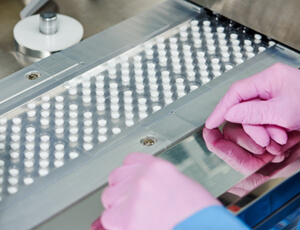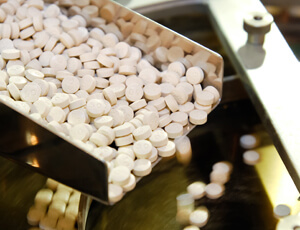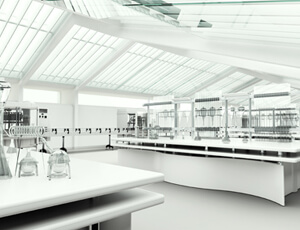Humidity control solutions for Pharmaceuticals
Despite business disruptions due to the pandemic, India continues to position itself as a stable and low-cost pharmaceutical manufacturer across the globe. In current times as well, the heavily regulated markets such as the USA, UK, Australia, Germany, France, etc. continue to bank on Indian pharmaceutical products.
For delivering consistent quality, the country has a robust network of 3,000 drug companies with around 10,500 manufacturing plants. Out of these, nearly 1400 WHO-GMP approved plants, and many are US-FDA compliant with modern state-of-art technology.
The strong infrastructure, and high-quality standards distinguish India as a consistent global pharmaceutical manufacturer.

While fulfilling global demands, India going forward will also cater to news healthcare needs, reduce its dependence on China for API manufacturing and ramp up its own production. India should become self-reliant for API manufacturing and concentrate more on R&D, innovation, adapting technological advancement for a brighter future. Investments in advanced dehumidification technologies are a prerequisite for pharmaceutical companies.
Stringent moisture control is required in Pharmaceutical
However, the more modern and technical pharmaceutical processes, the more stringent is the demand for the controlled environment to deliver a consistent quality of product with the longer shelf life. In this article, we are going to focus on various critical areas where stringent environment control is required.
In the surrounding environment, a certain amount of moisture is always present. This moisture can intrude the pharmaceutical production area through ventilation, frequent door openings.
Since, the majority of pharmaceutical products are hygroscopic in nature and have an affinity to the moisture. Thus, they instantly absorb moisture and deteriorate the chemical compounds.
Ingress of moisture during any stage of production like research & testing, processing, manufacturing, storage, packaging can cause affect the end quality.

Some of the common problems are disintegration, brittleness, non-uniform coating, short shelf life in tablet manufacturing, caking and lumping in powder manufacturing, inaccurate readings in rapid test kits and adverse event in pharmacovigilance, etc.
When moisture is torture … Research & Pharmacovigilance
In research facilities, environment control is paramount to conduct successful experiments. Especially today, when the whole world is eyeing on the covid vaccine. We must ensure that desired environmental conditions are maintained during its testing/trials and pharmacovigilance. Pharmacovigilance is a process to detect the adverse effects or drug reactions, finding its effectiveness and identify the possible risk factors. During pharmacovigilance, the presence of moisture can complicate the experiment/trial and distort the results.
Rapid Test kits
Along with preventive vaccine, the pharmaceutical industry is in dire need of the COVID-19 rapid test kits and other such critical diagnostic kits. These kits are one of the major demand drivers for moisture control solutions. The components used in rapid test kits are highly hygroscopic, tend to react with moisture and thereby may generate inaccurate test results. Thus, to ensure accurate test results, it is vital to provide recommended temperature and humidity level while assembling and manufacturing the Rapid Test Kits.

Medical plastics
Lately, we have observed the rising demand in usage of single-use medical plastics such as gloves, masks, gowns, and other PPEs. To reduce number of touch points and safeguard themselves from infections, they prefer single-use medicals plastics products, which are commonly used in surgical and procedural applications and general check-up. Besides, the demand of these disposables, various medical agencies, such as USFDA and Europe FDA, are propelling the demand for medical plastics globally. The medical disposables also need controlled environment during production and assembly. Effective moisture control solutions are required to prevent contamination, ensure safety and hygiene.
Powders
Powder Milling: Atmospheric moisture is the natural enemy of many grinding and pulverizing operations. The contact of water vapour with the product makes the material resilient, and therefore difficult to grind. The material clings to the grinding machine, and defies pneumatic conveying from one process to another.

Powder Storage: Most pharmaceutical powders are hygroscopic and moisture reactive. Maintaining low humidity in storage prior to manufacture, after manufacturing, and in packaging areas is of prime importance.
Dry Powder/Vial Filling: The filling operations include conveying of powdered substances to packaging areas in a high velocity airstream and filling minute quantities of the powder in the vials and capsules. High humidity may cause the powder to stick and cluster together in the conveyor, thus hampering airveying and filling operations.
Spray Drying: Dry Air helps speed up drying in spray drying systems. To get higher productivity through optimised drying of inlet air within set temperature limit, dehumidifiers are widely used by leading manufacturers in pharmaceuticals, food processing, chemicals etc.
Capsules
Soft Gelatin Capsule Manufacturing: In soft gelatin manufacturing, if the temperature and humidity are too high, gelatin will soften and prevent solidification. Excess moisture can make it brittle and crack easily. The drying of soft gel capsule is very tricky, as it has to be dried in very controlled temperature and humidity conditions, both of which should not exceed 20 along with specific air changes and time for drying. The moment any of the conditions deteriorate, the capsule may get brittle, extra soft, etc. Gelatine can be dried by circulating dehumidified air into the room maintained at 20% RH at 320°C
Capsule Storage: Finished capsules need to be stored in a dry environment prior to packaging to prevent moisture regain and spoilage of the product.
Strip Packaging: Dehumidified airveying of hygroscopic chemicals from storage to processing areas becomes critical in the pharmaceutical industry. Also, it is critical to prevent moisture regain when airveying moisture-sensitive products to filling and packaging operations. The final packaged material must maintain its validity during the expected shelf life. The product package must maintain the “as manufactured” moisture level considering that air is packed with the product in the
final step. Hence, the necessity to surround the packaging area with dry air.
Syrups
Cough Drops Manufacturing: During the manufacture of cough drops, the material which is in a plastic state becomes sticky when the humidity is high. Therefore, it sticks to the stamping machine, and also prevents the hardening of the surface coating of drops.
Tablets
Effervescent Tablet Manufacturing: Excess moisture in the manufacturing area reacts with the effervescent tablets, making them stick to the machines and affecting their surface finish.
Compounding of Tablets: Basic operation of chemical and pharmaceutical industries is the bringing together of the constituents, under precise conditions, to form compounds. Unwanted moisture may impede desired reactions or cause the formation of undesirable end products. Many diagnostic products used in medicine today involve radioactive material that must be mixed or compounded in a humidity-controlled environment. Aspirin and many other complex diagnostic compounds are moisture reactive. This leads to poor product quality and shortens shelf life. Potential problems like retarded growth in organic cultures, the disintegration of tablets, decomposition of formulations, shorter shelf life, etc.
Tablet Compression: Many materials used in medicines have a physical affinity for moisture, resulting in lumping and caking of powder. Powdered material compressed into tablet form under high pressure will adhere only in the dry state. Humidity may cause the failure of the tableting process, and in some cases, decompose the drug and lessen its medicinal value.

Tablet Coating: In the coating pan for tablets, heavy sugar solution is added to the tumbling mass. As the water evaporates, sugar crystals cover each piece. Blowing the proper quantity of air at the correct dry and wet bulb temperatures form a smooth and opaque coating. If the cooling and drying are not at the desired rate, the coating is rough, translucent and unsatisfactory in appearance. If the blowing is too fast, the coating chips go through to the interior.
AmoxyClav (Amoxicillin/ Clavulanic Acid): It is an antibiotic used for treatment of bacterial infections. It is a combination of amoxillin and clavulanate potassium (very sensitive materials) and has a high affinity toward moisture / water due to its inherent properties. Typically, RH required to be maintained is 15 ± 5% at18 ℃ which is not easily maintainable in tropical climates. If ideal conditions are not met, it results in a unstable product and has effect on the medicine dissolution. RH variation could lead to A typical flow diagram of Dry Injection.
Injections
Injection Manufacturing: Injections are prepared under sterile conditions. Injections/ampoules need to be prepared with humidity in the range of 45%, and sterile ampoule powders at 35% RH or lower. Processing of Dry Injection (RH/Temp Required – 15±5% at 21 ºC) The most critical operation in the above process is Filling and Sealing. The filling operation requires conveying of powder and filling the vials with the required amount precisely. The powder must be free flowing, and should be dry enough to avoid any lump formation or stickiness.
Penicillin
The penicillin incubation process requires temperatures and humidity rigidly controlled within ± 0.25 ºC and ± 3.3% RH. The manufacturing and packaging also require stringent temperature and humidity conditions. When packed in the presence of high humidity, it deteriorates due to carbon dioxide and water formation. Humidity control, therefore, becomes essential.
Diagnostic Rooms
Diagnostic rooms contain computers, sophisticated analytical instruments and analysers, which are sensitive to temperature, humidity and dust.
Humidity and temperature control are standard operating procedures for precision instruments.
Basic Drug
Basic drugs like Cloxacillin Sodium, Cephalexin, Norfaxasin, etc. are extremely hygroscopic. Thy tend to absorb moisture from the surrounding air during packaging, resulting in deterioration of quality and product spoilage. Dehumidifying the packaging area prevents damage and preserves the quality of the processed drugs.
Clean Rooms
Clean rooms are areas where contamination is totally controlled. All environmental parameters – airborne particles, temperature, humidity, air pressure, etc. are strictly monitored. Humidity control is an important variable in clean rooms.
Most pharmaceutical products are very hygroscopic and moisture sensitive and need humidity controlled clean room conditions for manufacturing and processing. Typically, powders when moist are difficult to process and have limited shelf-life. This problem can be managed by equipping clean rooms with Desiccant Dehumidifiers which allow faster manufacturing of quality product, and reduce loss of material during manufacturing.

Refrigerated Clean Rooms
Cold rooms or chambers are specially designed sheet metal or polyurethane refrigerated chambers, where required temperature and humidity conditions are maintained. Cold rooms are generally used in the industry to store perishable medical products, blood, vaccine, and other similar products. In these cold chambers, humidity control is achieved by installing dehumidifiers.
Pharmacy
Large hospitals often have their own pharmacy where drugs are processed, stored and packaged in bulk for further distribution. Presence of excess moisture or uncontrolled humidity in the pharmacy unit results in microbial and fungus growth. This spoils formulations and drugs processed or stored or packaged in these units. It is recommended to maintain these areas at less than 45% RH at 22ºC temperature. Desiccant Dehumidifiers not only maintain the required humidity level, but also ensure a clean environment as the unique desiccant provided in the dehumidifier selectively filters out bacteria and other spores.
Nutraceutical
Nutraceutical (essentially dietary supplements, medical and functional foods) are hygroscopic and require humidity control. The moist environment can yield inconsistent product and reduce production rate of nutraceutical. For example, Spirulina tablet is an example of nutraceutical, which is processed from its organic form (blue-green algae) into tablets under strict conditions of moisture control to maintain the desired quality.
Dehumidification is the key
The most simple and straight-forward way to obtain moisture-free air is to use desiccants that have natural liking for water. A desiccant is able to take up the additional moisture given up by the air without changing the size or shape or other properties of the pharmaceutical product. The technology/process is known as Dehumidification. Dehumidification is almost essential across all the various stages and processes of the Pharmaceutical Industry. From processing to manufacturing, storage, research and testing, packaging areas of the pharmaceutical industry, all require ideal RH conditions to be maintained. Thus, it has been recognized as an essential parameter of the pharmaceutical manufacturing process and as a specialization and science in its own rights.
Bry-Air can be the ideal partner for pharmaceutical Dehumidification needs. Bry-Air Dehumidifiers helps in providing the desired environment by controlling temperature and moisture levels for different chemical compositions/pharma products. Bry-Air Dehumidifiers can enhances productivity through environment control, efficiency in terms of time, cost, maintaining product quality, and a remarkable rise in throughput levels, followed by reduced downtime.
Especially, for the pharmaceutical industry, Bry-Air has designed the products that enhance productivity at a low cost, gains higher throughput with limited resources, and reach economies of scale. Our extensive range of best-in-class Bry-Air BrySmart series BrySmart series (BBS) Desiccant Dehumidifier is capable of delivering energy savings of up to 48%, plus an additional 20% through a customized rotor which reduces initial react energy input for the equivalent performance of the standard dehumidifier.




